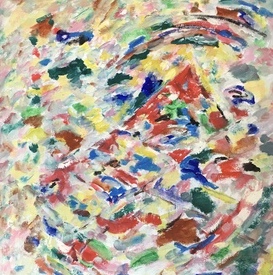Julien Dinou (Arnold Neuweiler): A Journey from Expressionism to Abstraction
Julien Dinou, born Arnold Eduard Neuweiler, came into the world on August 16, 1895, in Cairo, Egypt, and passed away on January 24, 1983, in Bern, Switzerland. A multi-talented artist, Dinou left a lasting mark on 20th-century art through a rich and unconventional career path.
Education and Early Career
Long before dedicating himself fully to art, Dinou pursued an impressive career across multiple disciplines. After studying chemistry, he worked as an engineer and business executive, notably leading the family company, Neuweiler AG. In parallel, he explored creative avenues as an actor, director, and writer. It wasn’t until his fifties that he turned definitively toward painting—a field in which he would make a meaningful impact.
Artistic Evolution and Influences
Julien Dinou emerged as an artist deeply influenced by his contemporaries, notably Paul Klee and Otto Nebel, both of whom were close friends. Over the decades, his artistic output evolved from figurative expressionism to a more abstract and geometric style. Dinou’s early works, which include figurative paintings, reflect emotional introspection and narrative richness. However, it was through abstraction that he fully explored the relationship between shape and color.
His style is characterized by bold geometric forms and a vibrant color palette. Inspired by the artistic movements of his time, Dinou developed a unique voice—oscillating between formal rigor and emotional expression. His mastery of various techniques, including watercolor and pastel, also positioned him as a versatile artist working at the crossroads of several artistic traditions.
Exhibitions and Recognition
Although Dinou did not achieve international fame during his lifetime, his work was exhibited throughout Europe, especially in Switzerland and Germany. Today, his artistic legacy is being rediscovered and appreciated by art enthusiasts, in part due to the ongoing preparation of a catalogue raisonné. This comprehensive effort aims to document his entire body of work, from his early expressionist pieces to his late abstract paintings.
One of his most emblematic works, L’horizon (1965), stands as a key example of his mature period, where geometric abstraction takes center stage. Today, his work is seen as a significant contribution to the development of abstract art in Europe—thanks in part to his close relationship with influential artists like Paul Klee, with whom he shared a quest for a new visual language of shape and color.
Major Works and Legacy
Dinou’s artworks—particularly his pastels and drawings—continue to captivate audiences. They reveal the complexity with which he viewed the world, translating his thoughts through compositions that are both refined and meaningful. His explorations of color and geometric form have inspired a generation of Swiss artists. Though his legacy may be discreet, it endures through retrospectives and posthumous exhibitions that bring renewed attention to his work.
Julien Dinou remains a remarkable figure in modern art—a testament to the enduring power of reinvention, creativity, and expression.

